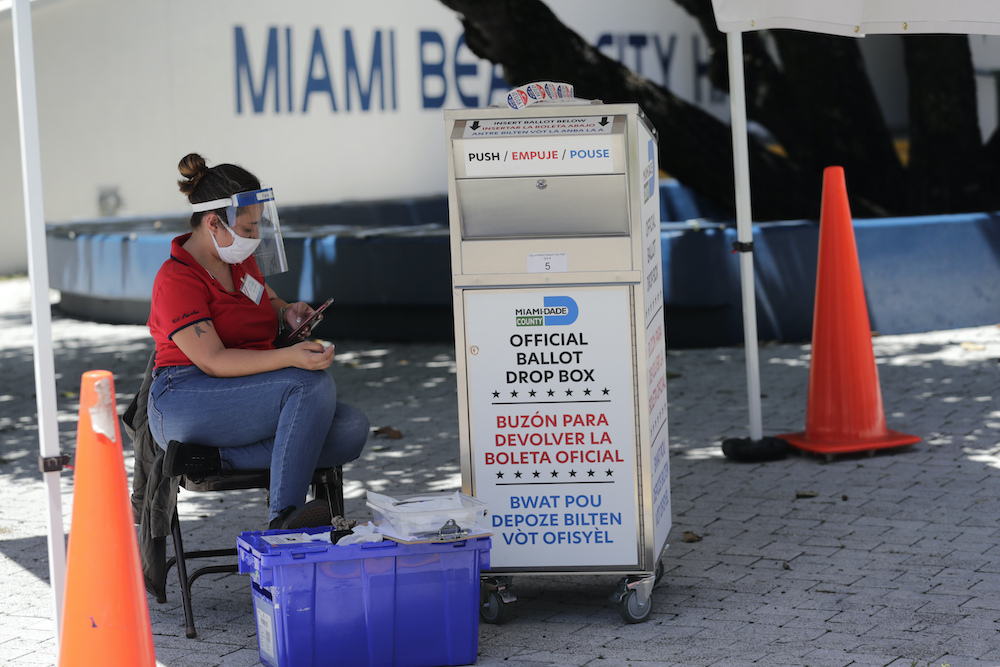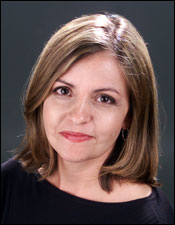
A poll worker wears a protective shield and mask as a precaution against the coronavirus as she monitors a ballot drop box for mail-in ballots outside of a polling station in Miami Beach, Florida during early voting in August 2020
I covered one of the closest presidential elections in modern history from Florida. But even with the knowledge we gained from the brutally divisive 2000 election to draw on, I’m not sure any of us could have been ready for this one.
We weren’t prepared back then, either — not the country, and not journalists. The spectacle of Bush v. Gore, with court battles and recounts and the world watching as the American presidency hung in the balance, was like no election before. Those six weeks broke most political norms. And in the end, the election was decided on 537 votes cast in Florida.
Twenty years later, Florida is bigger but just as divided. President Donald Trump — whose hallmark has become violating norms, and who calls Florida his home — has threatened not to accept a peaceful transfer of power if he loses. The pandemic has forced a nationwide reboot on how Americans cast their ballots, and a record number of Floridians are voting by mail, despite the president casting doubt on the process. There’s a fight raging about the restoration of voting rights for felons as we barrel toward Election Day.
I’m a political editor now, planning for an election in an unprecedented time as the landscape implodes over and over. On the day the president was supposed to be in Central Florida campaigning, for example, he announced he had Covid-19. We scrapped our planned coverage of the campaign stop and quickly wrote a different story that called into question the Miami debate scheduled for two weeks later. And when Trump, that same day, bowed out of a three-day bus tour in Florida along with other events, we had another story to file on the fly about the political void left in the state.
And the stakes for the work are high. A former Florida Supreme Court chief justice, Charles Wells, has become so worried about how the election is unfolding that he wrote an email to friends, published in part by news organizations, warning that he sees Trump’s refusal to commit to a peaceful transfer of power as a “grave and real threat to our democracy.”
Wells’ words are all the more alarming because he sat on the state’s highest court during the razor-thin 2000 election. He, as much as anyone, knows that Florida’s not just a crucial swing state with 29 electoral college votes. It’s also the intersection of so many trends that are shaping the country and roiling our 21st-century politics.
Covid-19 has certainly upended campaign season in Florida, but so has disinformation. The increasingly common accusations by Republicans that the Democrats want to turn the U.S. into a socialist state resonate strongly in South Florida, home to thousands who have escaped socialist or authoritarian regimes. In Miami, those loaded allegations are routinely raised in two — and sometimes three — languages.
And Florida’s elections remain close. It’s a swing state with close to 22 million residents from all over — Latin America, the Northeast, the Rust Belt — and voter rolls are divided more or less equally between Republicans and Democrats, with unaffiliated independents on the rise. As recently as the 2018 midterms, Florida saw races for the U.S. Senate, governor, and statewide agriculture commissioner go to recounts because they were so close, within half a percentage point or less.
The 2000 election exposed the fragility of the election system when the numbers are that tight. And it didn’t end until the U.S. Supreme Court, in a 5-4 decision, handed the presidency to George W. Bush — a ruling with particular relevance as Trump pulls out all the stops to get his Supreme Court nominee confirmed in the final weeks of the 2020 election.
Two decades later, in a vastly changed news business, the challenge of how to cover all that — with the added financial constraints of the pandemic-era newsroom and at a time when the press is blamed and attacked like never before — is part of a daily conversation that requires creativity, mental dexterity, and deep commitment to serve the public.
Coronavirus, though grindingly hard as the months have dragged on, has raised fairly straightforward issues: how to effectively cover campaigns that have been mostly virtual and, more recently, whether it’s safe to cover in-person events. Those aren’t small questions, but they are decisions we weigh with any kind of news coverage today.
But the flow of political disinformation in this election has forced us to struggle with more basic questions: how to write about outright lies, for example, without amplifying them; how to handle reporting on unfounded allegations that could undermine the election; how to write headlines that don’t thoughtlessly repeat misleading information in the zeal to find an audience.
Those are decisions we have to make every day. The leader of the Proud Boys extremist group, a Cuban American from Miami, became a focus of our coverage recently after the president wouldn’t disavow the group during the September debate. We didn’t stop there, though. We wrote about local political candidates who are members of the group and had taken photos with mainstream Florida Republican leaders. We had mentioned those connections in passing before; Trump’s debate comments elevated them to a critically important local and national story.
Wells, the former Florida Supreme Court chief justice, is among those trying to combat the rising tide of disinformation in this election cycle, including repeated unfounded comments by the president and his surrogates that the election is “rigged.” In a recent op-ed with another former justice, Barbara Pariente, Wells flatly stated that there is “no evidence of fraud in presidential elections in Florida before or after 2000.”
Wells was appointed by a Democrat but disagreed with the Florida Supreme Court majority that favored a recount in 2000, essentially siding with the Bush campaign. Wells’ dissenting opinion was cited by the U.S. Supreme Court in its landmark decision that shut down the Florida recount and handed the presidency to Bush.
Wells has said that a close, contested election could expose the same fault lines in 2020. The only real cure, he said, is for courts and election officials to count the votes quickly and resolve any legal challenges swiftly. And in an extraordinary request for a former justice, he asked his friends to vote for Democratic nominee Joe Biden in the hope that the margin in Florida would be large enough to make any potential litigation pointless.
“I set out my thoughts here because I am compelled to believe our country, and thus our children and grandchildren, face a grave threat to keeping the kind of representative democracy that we have experienced in our life,” he wrote. “I do not believe that we have had as serious a threat during our lives.”
In all the turmoil, though, there is still the baseline journalism work to be done. We must provide critical information for voters — who is this candidate and what are his or her qualifications? — while also trying to fact-check a torrent of false claims and deceptively edited audio and video clips, many of them amplified by anonymous actors or “bots” on social media.
Both are critical functions for the press, making for some tough decisions. But as we try to determine how best to serve readers, that tension can also lead to new ways of looking at coverage. For example, one way we are tackling the problem of disinformation is by crowdsourcing political advertising samples from our audience and then building an election ad “decoder,” an interactive feature that can help voters learn which organizations are behind misleading claims as well as identifying foreign interference.
Much has changed since 2000. We’re in a pandemic. Social media has become a dominant player for reaching voters. There are far fewer resources for journalists covering the election and far greater perils. Coverage is around-the-clock and disinformation is rampant.
We may not know what’s coming but we do know one thing. The need for smart, incisive journalism that cuts through the noise and disinformation is greater than ever.
Amy Driscoll, a 2003 Nieman Fellow, is an editor at the Miami Herald, where she leads coverage of politics and health care policy.

